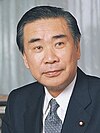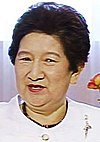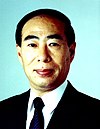Hosokawa cabinet
| Hosokawa cabinet | |
|---|---|
| 79th Japanese cabinet dai-79-dai naikaku |
|

|
|
|
Prime Minister Naikaku Sōri-Daijin |
Morihiro Hosokawa |
| choice | Shūgiin election 1993 |
| Legislative period | 127-129. Kokkai (40th Shūgiin , 16th Sangiin ) |
| Appointed by | Emperor Akihito |
| education | August 9, 1993 |
| The End | April 28, 1994 |
| Duration | 0 years and 262 days |
| predecessor | Miyazawa Cabinet (reshuffle) |
| successor | Hata cabinet |
| composition | |
| Party (s) | JRP , SPJ , Kōmeitō , JNP , DSP , NPS , SDF , DRP |
| minister | 21 (1 resignation) |
| State Secretaries | 2 parliamentary deputy heads of the Cabinet Secretariat 23 "parliamentary deputy ministers" |
| representation | |
| Shūgiin | 262/500 (at Premier choice 6.8.1993) |
| Sangiin | 132/252 (at the premier election) |
| Opposition leader | Yōhei Kōno (Shūgiin, LDP ) |
The Hosokawa cabinet ruled Japan under the leadership of Prime Minister Morihiro Hosokawa from August 9, 1993 until his resignation on April 28, 1994.
The Liberal Democratic Party (LDP) of its predecessor Kiichi Miyazawa had lost the absolute majority in the Shūgiin , the lower house, through resignations . In the Shūgiin election resulting from the successful vote of no confidence in Miyazawa in 1993 , the LDP was only able to gain one seat and was still without a majority. The previous opposition parties with the exception of the Communist Party of Japan agreed on a coalition and elected Hosokawa (against the new LDP chairman Yōhei Kōno ) as prime minister one day after the resignation of the old cabinet on August 5, 1993 .
The Hosokawa cabinet was presented on August 9 and formally appointed by the Tennō . It was the first without LDP participation since the founding of the party in 1955. It included 17 MPs from the Shūgiin and two from the Sangiin (upper house) , including the Prime Minister . Two ministers were not MPs. The New Japan Party (Nihon Shintō) only provided the prime minister. The Socialist Party of Japan ( Nihon Shakaitō, SPJ) provided six ministers, the Renewal Party (Shinseitō) five and the Kōmeitō four. The Democratic Socialist Party ( Minshatō, DSP), the New Party Sakigake (Shintō Sakigake) and the Social Democratic League (Shakai Minshu Rengō) each received a department. The "Democratic Reform League" (Minshu Kaikaku Rengō) , which was also included in the coalition, provided a parliamentary state secretary. Deputy Cabinet Secretaries were Yukio Hatoyama (New Sakigake Party) and Nobuo Ishihara; Takao Ōde remained the head of the legislative office .
The most important project was the initiation of a long-discussed reform of the electoral law, through which part of the mandates in the Shūgiin will be filled by proportional representation in a trench system . The value added tax, which was only introduced in 1989, was supposed to be increased from three to seven percent as kokumin-fukushi-zei ( 国民 福祉 税 , “people's social tax ”) to cover increased social spending . Both projects led to a dispute in the coalition (ultimately the value added tax was increased to 5 percent in 1997).
The cabinet was brought down by the Sagawa Kyūbin (Sagawa Express) donation scandal , which had contributed significantly to the LDP's loss of power and finally reached Hosokawa. On April 8, 1994, Hosokawa announced his resignation after it became public that he himself had received a dubious loan from Sagawa Kyūbin. The cabinet remained in office until Tsutomu Hata 's successor was elected on April 25 and the new cabinet was presented on April 28, 1994.
Minister of State
Resignations
- Defense Minister Nakanishi resigned on December 2, 1993 after challenging the constitutional prohibition (as interpreted at the time) on Japan's participation in UN peacekeeping missions .
- Prime Minister Hosokawa announced his resignation on April 8, 1994 after his involvement in the Sagawa-Kyūbin scandal became public.
Web links
Individual evidence
- ↑ a b FAZ.net December 14, 2015
- ↑ David E. Sanger: Japan Aide Ousted; He'd Criticized Arms Role. In: New York Times. December 3, 1993, accessed March 14, 2009 .
- ↑ How Scandal Finally Outran the reformer. In: Time. April 18, 1994, accessed March 14, 2009 .





